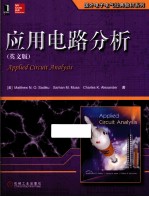图书介绍
应用电路分析 英文版PDF|Epub|txt|kindle电子书版本网盘下载

- (美)萨迪库等著 著
- 出版社: 北京:机械工业出版社
- ISBN:9787111417811
- 出版时间:2013
- 标注页数:694页
- 文件大小:112MB
- 文件页数:706页
- 主题词:电路分析-高等学校-教材-英文
PDF下载
下载说明
应用电路分析 英文版PDF格式电子书版下载
下载的文件为RAR压缩包。需要使用解压软件进行解压得到PDF格式图书。建议使用BT下载工具Free Download Manager进行下载,简称FDM(免费,没有广告,支持多平台)。本站资源全部打包为BT种子。所以需要使用专业的BT下载软件进行下载。如BitComet qBittorrent uTorrent等BT下载工具。迅雷目前由于本站不是热门资源。不推荐使用!后期资源热门了。安装了迅雷也可以迅雷进行下载!
(文件页数 要大于 标注页数,上中下等多册电子书除外)
注意:本站所有压缩包均有解压码: 点击下载压缩包解压工具
图书目录
PART 1 DC Circuits2
Chapter 1 Basic Concepts3
1.1 Introduction4
1.2 International Systems of Units5
1.3 Scientific and Engineering Notation6
1.4 ?Scientific Calculators8
1.5 Charge and Current10
1.6 Voltage12
1.7 Powerand Energy15
1.8 ?Applications16
1.8.1 TV Picture Tube16
1.8.2 Electricity Bills18
1.9 Summary18
Review Questions19
Problems20
Comprehensive Problems22
Chapter 2 Resistance23
2.1 Introduction24
2.2 Resistance24
2.3 Ohmis Law27
2.4 Conductance29
2.5 Circular Wires30
2.6 Typesof Resistors32
2.7 Resistor Color Code35
2.8 Standard Resistor Values37
2 9 Applications:Measurements38
2.10 Electrical Safety Precautions40
2.10.1 Electric Shock40
2.10.2 Precautions40
2.11 Summary41
Review Questions42
Problems42
Chapter 3 Power and Energy47
3.1 Introduction48
3.2 Power and Energy48
3.3 Power in Electric Circuits49
3.4 Power Sign Convention51
3.5 Resistor Power Ratings52
3.6 Efficiency53
3.7 Fuses,Circuit Breakers,and GFCls54
3.8 ?Applications:Wattmeter and Watt-hour Meter56
3.8.1 Wattmeter56
3.8.2 Watt-hour Meter57
3.9 Summary57
Review Questions58
Problems59
Chapter 4 Series Circuits63
4.1 Introduction64
4.2 Nodes,Branches,and Loops64
4.3 Resistors in Series66
4.4 Kirchhoff's Voltage Law68
4.5 Voltage Sources in Series71
4.6 Voltage Dividers71
4.7 Ground Connections73
4.8 Computer Analysis74
4.8.1 PSpice74
4.8.2 Multisim76
4.9 Applications77
4.10 Summary78
Review Questions78
Problems79
Chapter 5 Parallel Circuits87
5.1 Introduction88
5.2 Parallel Circuits88
5.3 Kirchhoff's Current Law89
5.4 Current Sources in Parallel91
5.5 Resistors in Parallel92
5.6 Current Dividers96
5.7 Computer Analysis100
5.7.1 PSpice100
5.7.2 Multisim100
5.8 Troubleshooting101
5.9 ?Applications103
5.10 Summary105
Review Questions105
Problems106
Chapter 6 Series-Parallel Circuits113
6.1 Introduction114
6.2 Series-Parallel Circuits114
6.3 Ladder Networks120
6.4 Dependent Sources123
6.5 Loading Effects of Instruments124
6.6 Computer Analysis128
6.6.1 PSpice128
6.6.2 Multisim128
6.7 ?Application:Wheatstone Bridge130
6.8 Summary131
Review Questions132
Problems133
Chapter 7 Methods of Analysis141
7.1 Introduction143
7 2 Mesh Analysis144
7.3 Mesh Analysis with Current Sources150
7.4 Nodal Analysis153
7.5 Nodal Analysis with Voltage Sources160
7 6 ?Mesh and Nodal Analysis by Inspection163
7 7 Mesh Versus Nodal Analysis166
7.8 ?Wye-Delta Transformations167
7.8.1△-to-Y Conversion168
7.8.2 Y-to-A Conversion169
7 9 Computer Analysis172
7.9 1 PSpice172
7 9.2 Multisim173
7.10 ?Applications:DC Transistor Circuits174
7.11 Summary176
Review Questions177
Problems178
Chapter 8 Circuit Theorems187
8.1 Introduction188
8.2 Linearity Propety188
8.3 Superposition190
8.4 Source Transformations193
8.5 Thevenin's Theorem197
8.6 Norton'S Theorem202
8.7 Maximum Power Transfer Theorem206
8 8 ?Millman's Theorem208
8.9 ?Substitution Theorem210
8.10 ?Reciprocity Theorem212
8.11 Verifying Circuit Theorems with Computers214
8.11.1 PSpice214
8.11.2Multisim217
8.12 ?Application:Source Modeling218
8.13 Summary220
Review Questions221
Problems222
Chapter 9 Capacitance231
9.1 Introduction232
9.2 Capacitors232
9.3 Electric Fields234
9.4 Types of Capacitors237
9 5 Series and Parallel Capacitors239
9.6 Current-Voltage Relationship242
9.7 Charging and Discharging a Capacitor245
9 7.1 Charging Cycle245
9.7.2 Discharging Cycle246
9.8 Computer Analysis249
9.8.1 PSpice249
9.8.2 Multisim252
9.9 Troubleshooting253
9.10 ?Applications254
9.10.1 Delay Circuits255
9.10.2 Photoflash Unit256
9.11 Summary258
Review Questions258
Problems259
Chapter 10 Inductance267
10.1 Introduction268
10.2 Electromagnetic Induction268
10.3 Inductors269
10.4 Energy Storage and Steady-State DC271
10.5 Types of lnductors273
10.6 Series and Parallellnductors274
10.7 Transient RL Circuits276
10.8 Computer Analysis279
10.8.1 PSpice279
10.8.2 Multisim280
10.9 ?Applications282
10.9.1 Relay Circuits282
10.9.2 Automobile Ignition Circuits283
10.10 Summary284
Review Questions285
Problems286
PART 2 AC Circuits292
Chapter 11 AC Voltage and Current293
11.1 Introduction294
11.2 AC Voltage Generator294
11.3 Sinusoids296
11.4 Phase Relations298
11.5 Average and RMS Values300
11.6 Oscilloscopes304
11 7 TrueRMSMeters305
11.8 Summary305
Review Questions306
Problems306
Chapter 12 Phasors and Impedance309
12.1 Introduction310
12.2 Phasors and Complex Numbers310
12.3 Phasor Relationships for Circuit Elements317
12 4 Impedance and Admittance319
12.5 Impedance Combinations321
12.6 Computer Analysis327
12.6.1 MATLAB327
12.6.2 PSpice327
12.7 ?Applications329
12.7.1 Phase-Shifters329
12.7.2 AC Bridges331
12.8 Summary333
Review Questions334
Problems334
Chapter 13 Sinusoidal Steady-State Analysis341
13 1 Introduction342
13.2 Mesh Analysis342
13.3 Nodal Analysis346
13 4 Superposition Theorem350
13.5 Source Transformation353
13.6 Thevenin and Norton Equivalent Circuits355
13.7 Computer Analysis360
13.8 Summaty362
Review Questions362
Problems363
Chapter 14 AC Power Analysis371
14.1 Introduction372
14.2 Instantaneous and Average Power373
14.3 Maximum Average Power Transfer376
14.4 Apparent Power and Power Factor379
14.5 Complex Power382
14.6 ?Conservation of AC Power386
14.7 Power Factor Correction389
14.8 ?Applications391
14.8.1 Power Measurement391
14.8.2 Electricity Consumption393
14.8.3 Power in CPUs395
14.9 Summary395
Review Questions396
Problems397
Chapter 15 Resonance403
15.1 Introduction404
15.2 Series Resonance404
15.3 Quality Factor407
15.4 Parallel Resonance409
15.5 Computer Analysis412
15.5.1 PSpice412
15.5.2 Multisim416
15.6 ?Applications417
15.7 Summary419
Review Questions420
Problems421
Chapter 16 Filters and Bode Plots425
16.1 Introduction426
16.2 The Decibel Scale426
16.3 Transfer Function431
16.4 Bode Plots434
16.5 Filters442
16.5.1 Lowpass Filter443
16.5.2 Highpass Filter444
16.5.3 Bandpass Filter444
16.5.4 Bandstop Filter445
16.6 Computer Analysis447
16.6.1 PSpice447
16.6.2 Multisim450
16.7 Applications451
16.7.1 Touch-Tone Telephone452
16.7.2 Crossover Network453
16.8 Summary455
Review Questions455
Problems456
Chapter 17 Three-Phase Circuits461
17.1 Introduction462
17.2 Three-Phase Generator463
17.3 Balanced Three-Phase Voltages464
17.4 Balanced Wye-Wye Connection466
17.5 Balanced Wye-Delta Connection470
17.6 Balanced Delta-Delta Connection473
17.7 Balanced Deita-Wye Connection474
17.8 Power in a Balanced System477
17.9 ?Unbalanced Three-Phase Systems482
17.10 Computer Analysis486
17.11 ?Applications490
17.11.1 Three-Phase Power Measurement490
17.11.2 Residential Electrical Wiring495
17.12 Summary497
Review Questions498
Problems499
Chapter 18 Transformers and Coupled Circuits505
18.1 Introduction506
18.2 Mutual Inductance506
18.3 Energy in a Coupled Circuit513
18.4 Linear Transformers515
18.5 ldeal Transfomers521
18.6 Ideal Autotransformers528
18.7 Computer Analysis531
18.8 ?Applications536
18.8.1 Transformers as Isolation Devices536
18.8.2 Transformers as Matching Devices538
18.8.3 Power Distribution539
18.9 Summary541
Review Questions542
Problems543
Chapter 19 Two-Port Networks551
19.1 Introduction552
19.2 Impedance Parameters552
19.3 Admittance Parameters556
19.4 Hybrid Parameters559
19.5 ?Relationships Between Parameters563
19.6 Interconnection of Networks565
19.7 Computer Analysis568
19.8 ?Applications572
19.9 Summary576
Review Questions576
Problems577